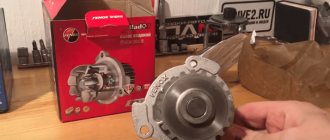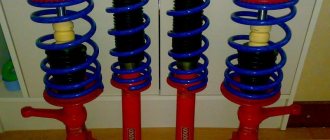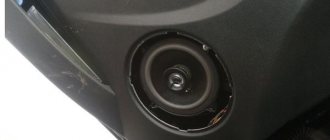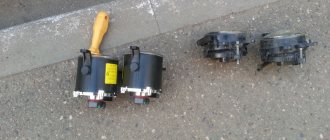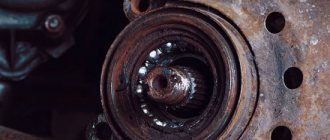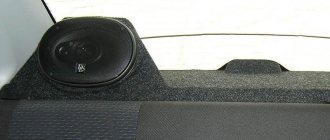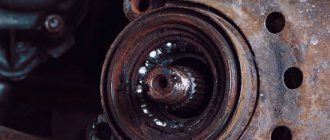An important component of the Lada engine is the pump or water pump of the cooling system. This model features engines with the serial index VAZ-11183, VAZ-11186, VAZ-21126 (also with automatic transmission) and VAZ-21127.
This unit should be selected according to the part numbers. After all, the Grant pump is responsible for the safety of such an important engine part as the timing belt. Pump (cooling system water pump) Lada Granta catalog number - 21114-1307010-00, 21114-1307010-01.
You can do a self-diagnosis of the pump malfunction yourself. This will only require a visual overview of the CO water pump department. When dismantling the pump, it will be easier to find the cause of the breakdown. Determination of malfunction Grant, pump:
• Makes noise, an unusual hum of bearings in the pump section. • Leaks in the pump area indicate the need to replace the gasket. • There may also be leaks in the drainage section of the pump - this is wear on the seal. • If the pump impeller wears out/breaks, there will be poor circulation of coolant in the system. • If axial play of the pump shaft is detected, the bearing is worn out.
The water pump ensures proper circulation of coolant in the car engine. Thus, infrequent monitoring, in which you should pay attention to the coolant pump section of the Lada Granta - the pump and the units associated with it, will serve you faithfully. And your car is no longer in danger of engine overheating due to a sudden malfunction. Do not forget that the performance of the stove also depends on the quality of the pump.
Unfortunately, counterfeit pumps are often found; be careful and always keep your purchase receipt or negotiate return conditions. Beware of fakes; after installation, carefully check the operation of the pump on a cold and warm engine.
The Lada Granta pump is represented by two reputable manufacturers. These are the companies TZA (Togliatti Plant of Units) and LUZAR (Lugansk Plant of Automobile Radiators). Pay attention to the colors of the original pump. Compare the grooves and stiffeners of the impeller. Compare all inscriptions on the pump with the original.
In auto markets you can find many water pumps for the Lada Granta. Choosing a good one without experience is not easy. Of course, it would be ideal to have the factory-made original with you for comparison. After all, the quality and prices at the bazaars are different, it is better to buy from official manufacturers; for comparison, the price of a pump on a grant is:
• TZA pump (21116-1307010-00) – from 815 to 1100 rubles. • LUZAR pump (21116-1307010-00) – average cost 1240 rubles. • Kraft – from 1550 rubles. • HEPU – from 1800 rubles. • In the markets you can also find supposedly “original” pumps for only 500 rubles. But it’s up to you to decide whether this untested part is worth purchasing.
Why do you need a pump in a car?
The power unit of any vehicle works in close connection with the cooling system. Constant circulation of antifreeze (or antifreeze) through the system ensures proper cooling of the engine and protects the rubbing parts of the engine from overheating. Accordingly, if there were no cooling system, the motor could not be considered a working unit - at the first load it heats up to a critical temperature and boils.
The operation of the cooling system fits into a simple scheme:
- The driver pours antifreeze into the expansion tank.
- After the engine starts, antifreeze begins to flow into the pump cavity.
- From there, the fluid under pressure is directed to the radiator device and to the cylinder block.
Accordingly, the pump in this scheme plays the role of pumping equipment, which ensures the continuous supply of coolant to the engine.
The device is made of hard metal alloys, which allows you to extend the service life of all moving and rubbing parts of the pump
On the Lada Granta, the pump starts when the engine is ignited. The pump itself is part of the gas distribution mechanism: its impeller blades will rotate as long as the pulley rotates through the timing belt.
Description and technical characteristics of water pumps DOLZ, LUZAR
The DOLZ pump is installed on Lada Granta cars with a modification of the VAZ 21116 engine. These are 8-valve units with a volume of 1.6 liters, a power of 87 horsepower, “Norma”, “Lux” equipment.
The manufacturer of the pump is Doltz, a Spanish concern that is famous for its high reliability and long service life of spare parts.
| Specifications | Equipment | |
| Paronite gasket | included 0.9 mm | 1.1 mm |
| Manufacturer | DOLZ | LUZAR |
| Belt pulley | In stock | In stock |
| Price | 1200 | 850 |
| Number of teeth | 21 | 21 |
| Warranty card | In stock | In stock |
| Type of packaging | Polyethylene | Polyethylene |
| Marking | Original number on the pulley, housing | Original number on the case |
| Impeller | Aluminum, six-blade, plastic coated, two mounting holes | Aluminum, seven-blade, three mounting holes |
| Impeller diameter | 63.2 | 64 |
| Pulley width | 24 | 27 |
| Distance to seat | 50 | 54 |
| Roller bearing outer diameter | 28 | 30 |
| Bearing width | 37 | 38 |
| Bearing type | Double row, ball | Ball roller |
| Roller diameter | 4.4 | 4.8 |
| Length of one roller | 8.4 | 12.0 |
| Ball diameter | 6.4 | 6.3 |
| Seal type | ceramics | ceramics |
Reinforced pump Luzar for Lada Granta 2190
Luzar Turbo 2 is a high-power water pump for the Lada Granta. The average cost in the Russian Federation is 650 – 750 rubles, depending on the place of purchase. Pump flow rate at 800 rpm is 900 l/h. The unit runs 95 – 120 thousand km.
The installation of a turbo version of the pump is explained by the fact that the engines of the Lada line are prone to rapid boiling and an increase in operating temperature.
The temperature increases according to the following scheme: the car moves at high speeds on the road. A sudden stop at a traffic light provokes a rise in temperature, heat stroke, and boiling of antifreeze.
| Characteristic | Indicators |
| Material | Poly Phenylene Sulfide |
| Strength | up to 210 M Pa |
| Elasticity | up to 21,000 M Pa |
| Impact resistance | up to 51 kJ/m2 |
| Stability under load | Yes |
| Performance | -60 to +220℃ |
| Resistance to hydrolysis | 0,03% |
| Low shrinkage | Yes |
Signs of a pump malfunction on a Lada Granta car
"Lada Granta" continues the best traditions of the automotive industry of the domestic plant, and therefore its design does not cause any particular difficulties in diagnostics. To identify a pump malfunction, you do not need to look at the instruction manual or contact the services of a service station specialist. There are only three signs of a water pump failure that the driver can identify on his own.
The engine started to get very hot
If the Granta, even in winter, starts to get very hot while driving, and the fan can no longer cope with cooling the engine, then this is a clear sign that the pump has failed. The thing is that the presence of coolant in the system does not yet guarantee engine cooling, since if there is no pressure, then the liquid simply will not flow to the cylinder block.
You can confirm your suspicions in a fairly simple way:
- Start the engine.
- Wait until the engine warms up to its operating temperature.
- Turn on the stove.
- If only cold air begins to come out of it, then the circulation of antifreeze in the system is disrupted. Most likely, the problems are associated with severe wear of the pump impeller blades, and therefore you need to replace the pump with a new one as soon as possible.
Instrument readings in the cabin indicate that the engine is very hot - this is a reason to look under the hood and check the condition of the pump
Timing belt wears unevenly
Often drivers, having decided to change the timing belt, are surprised to notice that it is worn out on only one side. Of course, this is not normal for the operation of a rubber product - the timing belt design is designed for uniform planned wear of each part.
The timing belt rubs on one side due to the fact that the bearings on the pump shaft are loose . Accordingly, if there is asymmetrical wear on the timing belt, this indicates that the pump is about to fail. Usually, if the bearings become loose, the driver hears a loud crunching or banging sound from under the hood while driving.
Even after a short period of operation, the belt will begin to wear out on only one side if the pump bearings are worn out.
Pump leaking
Even a high-quality water pump cannot last forever. Therefore, over time, the pump seal (the most vulnerable component of the pump) will begin to wear out and, as a result, leak. And an antifreeze leak in the timing belt area clearly indicates that the pump has lost its tightness and is no longer performing its function to the required extent. Of course, if the leak is small, then the car can be used for now, since the system will still provide engine cooling. However, at any moment the oil seal can completely break through, and all the antifreeze will flow out of the crankcase.
In some cases, water pump leaks are observed not only due to the wear-out of the oil seal, but also due to improper installation of the rubber seal when replacing the pump.
Abundant release of antifreeze in the timing belt indicates depressurization of the water pump
Signs and causes of failure
You can identify a broken part by the following signs:
- insufficient circulation of coolant and, as a result, frequent overheating of the engine;
- hum of bearings at the pump mounting location;
- presence of smudges at the pump mounting location.
These markers indicate the most likely causes of malfunctions in the Grants pump:
- bearing wear or damage;
- damage to the seal;
- worn sealing gasket;
- broken pump impeller.
In most cases, the part becomes unsuitable for major repairs and requires a complete replacement. Ignoring pump problems leads to replacing the timing belt and replacing components of the connecting rod and piston group. Valves and bearings may also need to be replaced.
Price issue
Replacing the pump on a Grant will not significantly impact the car owner’s budget. The cost of a new part is in the range of 1000-2000 rubles. For a thousand you can order a “native” pump produced by AvtoVAZ. Closer to the upper price threshold are expensive foreign-made analogues with an increased resource. The average service life of a new pump is 150,000-170,000 kilometers.
Replacing the water pump on Grant (8 valves)
The driver can change the pump on an 8-valve Lada Granta without going to a service station. The main thing is to follow the replacement instructions and, upon completion of the replacement, set the crankshaft and pulley values correctly. Usually, along with the water pump, it is customary to change the timing belt.
Where is the pump located?
Since the pump is put into operation by a gas distribution mechanism, it is quite obvious that it will be built into the timing system. That is, you need to look for the location of the pump on the Lada Granta on the right side of the engine.
It is impossible to visually see the pump before removing the timing belt - only the pump pulley is visible, which is what starts the impeller into operation.
The water pump is included in the timing belt assembly
Preparing tools
To work, you will need several wrenches, standard auxiliary tools and materials:
- wrench 10;
- socket head 10;
- wrench 17;
- a screwdriver with a flat and thin blade;
- sealant;
- container for draining coolant (at least 10 liters);
- rags.
Replacing the pump on a Lada Grant does not require special tools - a standard set of tools is enough
How much coolant should be drained and refilled when replacing
Regardless of the availability of time or desire of the driver, you will still have to drain the antifreeze when changing the water pump. This is necessary in order to relieve the existing pressure in the cooling system and protect yourself from possible risks. However, the main question is how much liquid needs to be drained.
Traditionally, when replacing a pump, the entire volume of antifreeze is drained, since the new water pump will need new coolant. However, if new antifreeze was recently filled in, then there is no point in replacing it. It is enough to drain 4–5 liters of liquid to reduce the pressure, and then pour the same liters back.
Antifreeze is completely drained in 10–15 minutes
Draining can be done in two ways:
- Disconnect the pipes from the radiator and place a container under the drain holes. This method allows you to remove almost all liquid from the cooling system.
- Unscrew the plug from the expansion tank housing - no more than 5 liters of antifreeze will leak out.
New coolant should be added only after all installation work has been completed. It is recommended to make sure that the antifreeze supply and discharge hoses are tightly connected to the fittings.
Pump replacement procedure
On an 8-valve Lada Granta, changing the water pump is somewhat easier than on a 16-valve one. All actions of the owner fit into the following scheme:
- Drain the antifreeze.
- Disconnect the wire from the negative terminal on the battery.
- Place a jack under the front right wheel and remove it.
- Next, unscrew the screws securing the timing case housing. Remove the casing.
- Loosen the timing belt tensioner roller.
- Reduce the tension on the alternator drive belt.
- Remove the timing belt and the alternator belt.
- Disconnect the inlet and outlet hoses from the pump. It is enough to loosen the degree of compression of the metal clamp with a screwdriver, and the pipes can be easily removed. Antifreeze may leak, so it is better to place a container under the pump fittings or place a rag in advance.
- Remove the cover from the pump.
- Unscrew the nuts securing the pump to the motor wall.
- Pull out the pump.
- Immediately after dismantling, you will need to clean the flange surfaces from leakage of antifreeze and dirt deposits, and be sure to remove any residue from the rubber gasket.
Photo: work procedure when replacing a pump
It is very easy to de-energize the car to safely replace the pump - just remove the negative wire from the battery terminal
It is best to remove drive belts after they have been loosened - this will make the procedure faster
Removing the water pump is done with bare hands - just pull the pump housing and it easily comes out of the socket
After this, you can install a new one in place of the old pump. All stages of work are performed in reverse order. Before installing the water pump, it is recommended to apply a thin layer of sealant to the gasket and wait 10 minutes until it dries a little. The sealant will create additional integrity of all pump elements and extend the life of the seal.
Video: comprehensive replacement of the pump and timing belt
https://youtube.com/watch?v=-u9mvj90Z08
Korean-made coolant pump for VAZ-21179 engine
The owner of any elderly foreign car with a timing belt will confirm that repairmen insist that during a scheduled belt change, they replace both the pump and the pressure rollers with bearing assemblies. And these parts are often sold as a set. Moreover, at a discount - the whole set is cheaper than the belt, rollers, and pump separately.
I don’t want to once again convince you that the stingy pays twice, but over the years I have come to the conclusion that Western manufacturers include in the regulations changing the belt not because of the belt as such, but because of the pump and tensioner bearings. They just needed a reason to reliably replace the entire set of parts associated with the camshaft drive, and they found it.
I propose to do the same with our engines. Why? Formally, at each maintenance it would be necessary to remove the cover and inspect the timing belt and water pump. You can see a tear in the belt, as well as a leak on the pump. In both cases, the part is changed without delay. But this is a malfunction. And if everything is outwardly normal, the ideal option is to include preventive replacement in the regulations.
Preparatory stage
The Lada Granta car can be equipped with two types of power units - 8 valves and 16. The difference in the timing mechanisms of these engines is that the 16-valve version has 2 camshafts, respectively, 2 gears instead of one in the 8-valve version. In addition, in addition to the tensioner, the mechanism contains an additional deflection roller.
They should also be replaced together with the timing belt, because worn rollers can cause the belt to break or jump on the gears. Then the valve timing is disrupted, the engine begins to “shake”, and the power drops noticeably. The replacement operation is quite accessible to any car enthusiast who has such a desire and some tools:
- a set of the most popular open-end wrenches and sockets;
- mounting blade (mount);
- flat screwdriver;
- jack;
- round nose pliers with curved pointed ends or a special fork for the tension roller;
- cloth gloves.
1 — toothed pulley of the engine crankshaft; 2 — tide on the oil pump cover; 3 — toothed pulley of the coolant pump; 4 - tension roller; 5 — toothed pulley of the exhaust camshaft; 6 — rear timing belt cover; 7 — toothed pulley of the intake camshaft; 8 — guide roller; 9 — toothed belt; A - TDC mark on the crankshaft toothed pulley; B — mark on the oil pump cover; C, F - mark on the rear timing belt cover; D — mark on the gear pulley of the exhaust camshaft; E - mark on the intake camshaft toothed pulley

